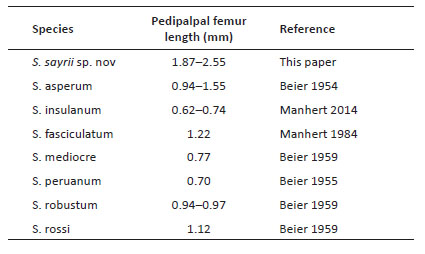INTRODUCTION
During a series of fauna evaluations carried out in 2021 at Pucllana, an archaeological site in the city of Lima, Peru, a new species of arachnid was recorded and assigned to a pseudoscorpion of the genus Stenolpium Beier, 1955.
The genus Stenolpium is endemic to the South American Pacific coasts and belongs to the family Hesperolpiidae Hoff, 1964, which is distributed mainly in xeric environments (Harvey & Leng 2008, Barba 2020); this family includes 12 genera and 93 species (World Pseudoscorpiones Catalog 2022). Prior to this study, seven species of Stenolpium have been described: S. asperum Beier, 1954; S. fasciculatum Mahnert, 1984; S. insulanum Beier, 1978; S. mediocre Beier, 1959; S. peruanum Beier, 1955; S. robustum Beier, 1959 and S. rossi Beier, 1959. Five of these species have been recorded only in Peru; the only ones not endemic to Peru are S. insulanum, endemic to the Galapagos Islands, and S. asperum, recorded in Peru and Chile (World Pseudoscorpiones Catalog 2022). To date, a total of 44 species of pseudoscorpions have been recorded in Peru (World Pseudoscorpiones Catalog 2022).
In the present paper, Stenolpium sayrii sp. nov. is described from Pucllana, based on male and female specimens. This finding is surprising given that Pucllana is located in an urban neighborhood of Lima, the capital of Peru, which, with more than 10 million inhabitants, is the most populated Peruvian city.
MATERIAL AND METHODS
Pucllana is a pre-Columbian archaeological site of the Lima culture, dating approximately from 200 to 700 AD. It is built with mud bricks in an area located in Lima city, in the district of Miraflores, and has a surface of 6.07 ha surrounded by streets, parks and houses (Fig. 1).
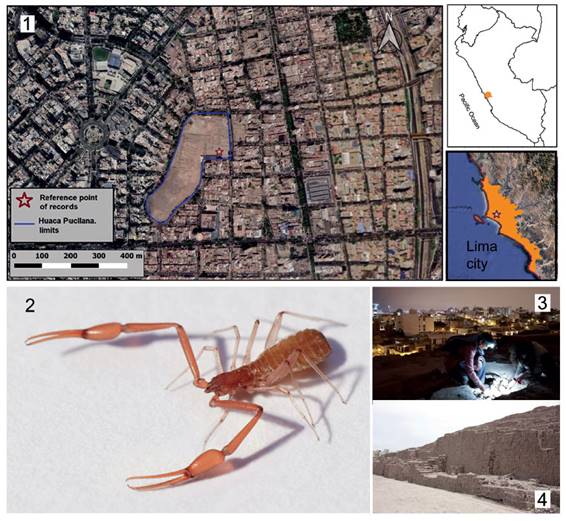
Figures 1-4 Distribution, habitat and habitus of the new species. 1: Map of the species´ known distribution. 2: Habitus of an adult female of Stenolpium sayrii sp. nov. 3: Working team at Pucllana, Miraflores, Lima. 4: View of the habitat. Photographs: 3 Eddy Diaz; 2, 4 Daniel Cossios.
The specimens reviewed in this work were searched at night, with flashlights, for three nights per month, from 20:00 to 23:00 hours each night, throughout the entire year 2021. During each evaluation night, approximately 70% of the archaeological site was covered. Only adult specimens were captured. The specimens were collected with the help of tweezers, stored in vials with 70% ethanol and deposited in the entomological collection of the Natural History Museum of San Marcos University. The specimens, including a single male, were not cleared for examination.
Terminology and measurements followed Chamberlin (1931) with the modifications proposed by Harvey (1992) for the trichobothria and Judson (2007) for the chelicerae. The abbreviations used for the trichobothria were: b = basal; sb = sub-basal; st = sub-terminal; t = terminal; ib = interior basal; isb = interior sub-basal; ist = interior sub-terminal; it = interior terminal; eb = exterior basal; esb = exterior sub-basal; est = exterior sub-terminal; and, et = exterior terminal. Abbreviations used for the cheliceral setae were: is = interior seta; ls = laminar seta; es = exterior seta; bs = basal seta; sbs = subbasal seta; gs = galeal seta.
Illustrations were made using a stereomicroscope (Euromex, model Nexius Zoom) and a camera lucida. Digital images of fixed specimens were taken under visible light, using a camera (Euromex, model CMEX 18 Pro) attached to the same stereomicroscope, and the stacked images were processed with Helicon Focus 3.10.3 (http://helicon.com.usa/heliconfocus/). Images of a live specimen were taken with a digital camera Sony alpha 6400. Measurements were obtained following the methodology of Botero-Trujillo et al. (2017) and are expressed in millimetres.
TAXONOMY AND DESCRIPTIONS
Family Hesperolpiidae Hoff, 1964
Genus Stenolpium Beier, 1955
Type species. Stenolpium peruanum Beier, 1955, by original designation.
The new species is placed in Stenolpium because it has the typical characteristics of the genus, e.g., 1) granulated carapace and pedipalps; 2) trichobothria arrangement characterized by a fixed finger with eight trichobothria: ib dorsally placed, ist prolaterally placed, all others retrolaterally placed; eb, esb, ib and isb in the basal portion of the finger, est, ist, it and et at the distal portion; movable finger with four trichobothria, all externally placed; 3) a tactile seta on the pedipalpal femur; and 4) pedipalp having a cylindrical and elongated femur, patella slightly conical, hand dorsally triangular and broad, fingers slender and elongated compared to the hand.
Stenolpium sayrii sp. nov.
Type material. Holotype male (MUSM-ENT 0516779): Peru, Lima city (department and province of Lima), Miraflores district, Huaca Pucllana (Figs 1-2), [12°06’38”S, 77°02’00”W], 105 m elevation, 11 April 2021, E.D. Cossios coll. Paratypes: 2 females (MUSM-ENT 0516780), Huaca Pucllana (13 April 2021), E.D. Cossios coll.
Etymology. The specific name is a patronym for Sayri Cossios Veillon, who helped find the specimens described here.
Diagnosis. Stenolpium sayrii sp. nov. differs from S. asperum, S. insulanum, S. mediocre, S. peruanum, S. robustum and S. rossi by having a putative sensory organ formed by multiple short setae on the pedipalpal movable finger, by the trichobothria arrangement with st very close to t, and ist-it-et distal with respect to t, and much more elongated legs and pedipalps (Table 1).
Stenolpium fasciculatum is the species most similar to S. sayrii sp. nov., both having the sensory organ on the pedipalpal movable finger, the same trichobothria arrangement and elongated appendages; however, these two species can be distinguished because S. sayrii has more elongated pedipalps and legs (Table 2), as well as an anteromedial furrow on the carapace and a different carapace chaetotaxy.
Table 2 Measurements (in mm) of Stenolpium sayrii sp. nov. and Stenolpium fasciculatum. Data for S. fasciculatum from Manhert 1984. l = length, b = breadth, d = depth.Description of the male holotype. Color in vivo (Fig. 5). Carapace, chelicerae, and pedipalps reddish brown, abdomen yellowish, legs reddish, lighter than carapace. Color in ethanol: same as in life.
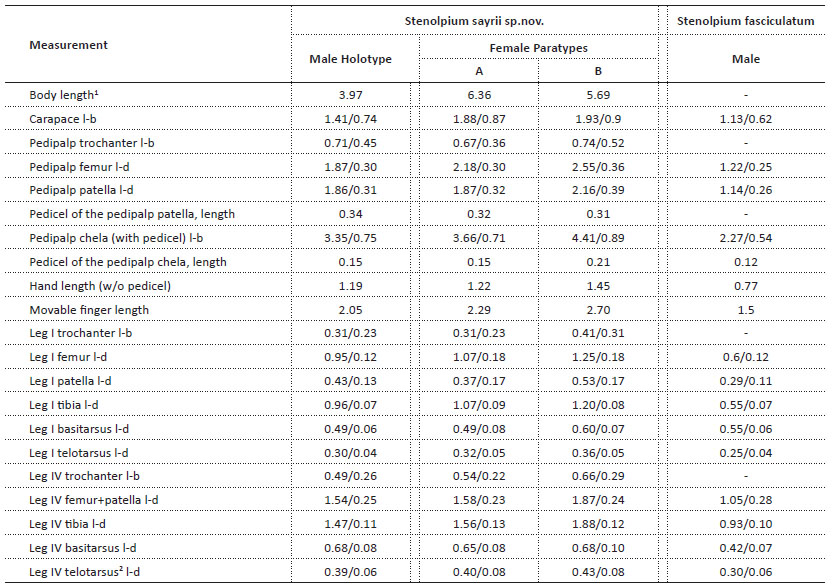
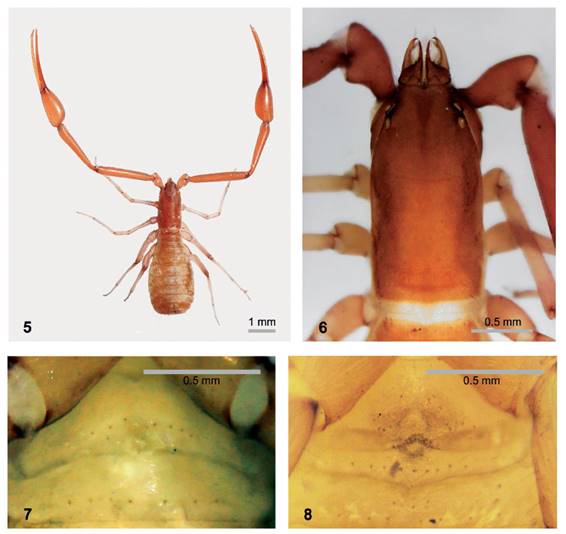
Figures 5-8 Stenolpium sayrii sp. nov. dorsal aspect, prosoma and genital area. 5, 6, 8: Male holotype. 7: Female paratype.
Carapace (Fig. 6 9). Finely granular, 2.14 times longer than broad, with anteriomedian transverse furrow, posterior margin elevated, and lateral margins depressed at the medial region. A total of 20 setae, including six on anterior margin, four on posterior margin, two preocular setae at each side and one seta between each pair of eyes. Cucullus elongated, with sinuous anterior margin.
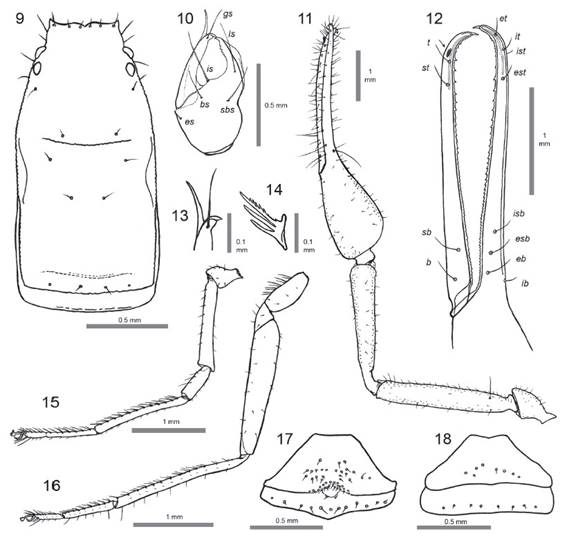
Figures 9-18 Stenolpium sayrii sp. nov. holotype male (10-16), female (18). 9: Carapace, dorsal view. 10: Left chelicera, dorsal view. 11: Left pedipalp, dorsal view. 12: Left chelal fingers, retrolateral view. 13: Distal part of the movable finger of the left chelicera, showing the galea and the galeal seta. 14: Rallum of the left chelicera. 15: Left leg I, retrolateral view. 16: Left leg IV, retrolateral view. 17: Male genitalia area showing sternites II and III. 18: Female genitalia area showing sternites II and III. The arrow on Fig. 12 shows the putative sensory organ on pedipalpal movable finger.
Chelicera (Fig. 10). Hand with five setae, all of them without setulae; fixed finger with five teeth and lamina externa; movable finger with one subdistal seta; serrula exterior with 24 lamellae; serrula interior with 17 lamellae. Galea 0.09 mm long, without rami (Figs. 10, 13). Rallum with three blades (Fig. 14).
Pedipalps (Figs. 11-12). Coxae with distal ends visible next to the cucullus and eyes from a dorsal view (Fig. 6), laterally granulated and with eight ventral setae. Trochanter, femur, and patella finely granulated. Femur cylindrical, with a tactile seta (trichobothria) dorsally placed on the first quarter of its length, patella slightly conical. Hand finely granulated only on its mesal portion, chelal fingers smooth. Trochanter 1.58, femur 6.23, patella 6.00 times longer than wide; pedicel about 1/5 the entire length of patella; chela (with pedicel) 4.46, chela (without pedicel) 4.26 times longer than wide, movable finger 1.72 times longer than hand (without pedicel). Fixed chelal finger with eight trichobothria: ib dorsally placed, close to the base; ist prolaterally placed; eb, esb, isb, est, it and et retrolaterally placed; eb, esb and isb grouped at the base, est, ist, it and et in the distal portion of the finger; ist, it and et placed distally to t. Movable chelal finger with four trichobothria, all retrolaterally placed: b and sb close to the base, st and t on the distal portion; distally close to t, a depression with many short setae (Fig. 12), probably a sensory organ, is found. Venom apparatus present in both fingers; venom ducts long, reaching est in the fixed finger and surpassing st in movable finger. Fixed chelal finger with 59 teeth, more elongated on the distal part of the finger. Mobile finger with 11 clearly distinguishable teeth in the distal third of the finger and a large number of teeth in the rest, rounded in the proximal third and fused together and barely distinguishable in the middle of the finger.
Abdomen. Tergal chaetotaxy (I-XI): 6/6/6/8/8/8/8/9/8/6/8, the outermost seta on each side of the sternite XI is very long (trichobothria); sternal chaetotaxy (IV-XI): 9/13/14/10/8/10/12/8; anal cone with two dorsal and two ventral setae. Male genital area (Figs. 8, 17): sternite II with 23 scattered setae on the anterior portion and 25 setae on the central part of the posterior border; sternite III with anteromedian groove flanked by one small seta on each side, and 12 setae on the posterior margin.
Legs. Coxal chaetotaxy (I-IV): 15/21/17/19. Leg I (Fig. 15): femur 7.92, patella 3.31, tibia 13.71, basitarsus 8.17, telotarsus 7.50 times longer than deep, femur 2.21 times longer than patella, basitarsus 1.63 times longer than telotarsus. Leg IV (Fig. 16): femur + patella 6.16 times longer than deep; tibia 13.36, basitarsus 8.5, telotarsus 6.5 times longer than deep; basitarsus 1.74 times longer than telotarsus; tibia with one distal tactile seta, basitarsus with one proximal and one distal tactile setae, telotarsus with one distal tactile seta; arolium not divided, longer than the slender and simple claws.
Description of Females (paratypes) (Fig. 2). Same color as the male. Other morphological characters also same as the male, except the following:
Carapace. 2.14-2.16 times longer than broad.
Pedipalps. Trochanter 1.42-1.86, femur 7.08-7.27, patella 5.54-5.84, chela (with pedicel) 4.95-5.15, chela (without pedicel) 4.72-4.94 times longer than wide, movable finger 1.86-1.88 times longer than hand (without pedicel). Fixed chelal finger with 57 teeth.
Abdomen. Tergal chaetotaxy (I-XI): 7-8/4-6/8/8/8/8-10/8-10/9-10/8/7-9/8; sternal chaetotaxy (IV-XI): 8-10/12/10-12/11-12/9-10/10/10/8; anal cone with two dorsal and two ventral setae. Female genital area (Figs. 7, 18): sternite II with 8-18 scattered setae; sternite III with a row of 8-10 setae on the posterior margin.
Legs. Coxal chaetotaxy (I-IV): 12-14/17-20/16-17/18-20. Leg I: femur 5.94-6.94, patella 2.18-3.12, tibia 11.89-15.0, basitarsus 6.12-8.57, telotarsus 6. 4-7.2 times longer than deep, femur 2.36-2.89 times longer than patella, basitarsus 1.53-1.67 times longer than telotarsus. Leg IV: femur + patella 6.87-7.79 times longer than deep; tibia 12.0-15.67, basitarsus 6.8-8.12, telotarsus 5.0-5.37 times longer than deep; basitarsus 1.58-1.62 times longer than telotarsus.
Measurements. Table 2 shows measurements of the male holotype, the female paratypes and a male of Stenolpium fasciculatum.
Variation. Variation of some measurements is shown in Table 2. No significant variation in other characters was observed.
Distribution. This species is known only from the type locality, which, according to Morrone (2001), is located in the Coastal Peruvian Desert biogeographical province, in the Andean Region.
COMMENTS
Pucllana is characterized by a very arid environment with a soil and stone substrate, very different from the surrounding sites made up of cement surfaces and parks with vegetation and irrigation. The author searched for the species described here in some parks near Pucllana, without success. However, Stenolpium sayrii sp. nov. is probably present in other arid environments, such as other archaeological sites or in the periphery of Lima city.
The species most closely resembling Stenolpium sayrii sp. nov. is S. fasciculatum. Stenolpium fasciculatum has been documented from a single specimen discovered in Chiclayo (Manhert 1984), a location situated over 600 km north of Pucllana. Chiclayo, positioned in the Peruvian coast, features an arid environment similar in climate and substrate to the habitat where S. sayrii sp. nov. was discovered. To the best of author’s knowledge, no records of Stenolpium pseudoscorpions have been published on the Peruvian central coast since 1959 (Roewer 1959), although they appear to be relatively common species at some sites (personal observation). These observations suggest that the lack of records of this genus in the Peruvian coast is mainly due to the lack of inventories, and not to the absence or rarity of these animals. Additional field works will help to discover a higher diversity of species in arid environments along the desert coast of Peru, in particular between Lima and Chiclayo, where at least two species of Stenolpium occur.
With the description of this species, the number of pseudoscorpions of the genus Stenolpium reaches to eight, seven of these recorded in Peru.
The discovery of this new species in the most populated Peruvian city is an example of how much research remains to be done on Peruvian fauna in general and on its arachnids in particular.












 uBio
uBio 

